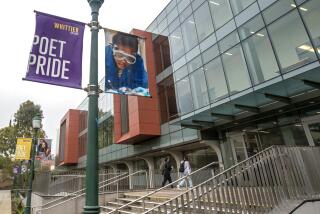Nixon Teacher, Former Whittier College Head, Dies
- Share via
Paul Samuel Smith, former Whittier College president and mentor to former President Richard M. Nixon, died recently at age 93.
The Whittier resident died May 18 after a brief illness.
Smith, a respected history scholar and teacher, became the college’s eighth president in 1951 and held the position through 1969. During his tenure, enrollment rose from 800 to 2,000, and the college established a Copenhagen school, one of the first campuses overseas to encourage students to study abroad.
But Smith’s presidency may be remembered best for bricks and mortar. “He was very good at convincing donors to help build buildings,” said Roy Newsom, another former Whittier College president. More than a dozen buildings went up during Smith’s tenure, including the college chapel where students and colleagues gathered last Saturday for a memorial service.
Nixon, a 1934 graduate of Whittier College, wrote one of the tributes for the memorial. “During my 45 years in the political arena, no one inspired and influenced me more than Dr. Paul Smith,” Nixon wrote. “He was the best of scores of teachers I had in high school, college and law school.”
Smith would lecture in his history courses on leaders such as Presidents James Madison and James Monroe in a way that inspired his students to follow in their footsteps, Whittier College Trustee C. Milo Connick said. Smith believed “in free enterprise and individual initiative,” Connick said. “He believed that history was the length and shadow of great men.”
Smith, an author of several books on American politics and the Constitution, criticized other scholars for what he called “debunking the heroes of American history” and breeding “a disrespect for the past.” Smith believed that educators did a disservice by downplaying the virtues of democracy in an effort to be nonpartisan.
Smith was born in Richmond, Ind., and attended a one-room schoolhouse where he read Poe, Byron and biographies from the Congressional Record.
At Earlham College, a nearby Quaker school, he studied political science and served as student body president, returning home every afternoon to do farm chores. He received his master’s and doctorate degrees at the University of Wisconsin and began teaching at Whittier in 1922. He became known both for his oratory and his camaraderie with students. He would often join them in pickup basketball games.
He made one his last public appearances four months ago at a memorial service for his wife, Lillian. Smith struggled to get out of his chair and slowly crossed the few feet to the speaker’s podium, Connick said, but he retained the voice that once held students spellbound.
“He talked about the things he and Lillian were interested in throughout their lives,” Connick said, such as world peace and helping the unfortunate. “He said these things hadn’t materialized according to their hopes, but it was incumbent on humankind to keep working on them.”
More to Read
Sign up for Essential California
The most important California stories and recommendations in your inbox every morning.
You may occasionally receive promotional content from the Los Angeles Times.














